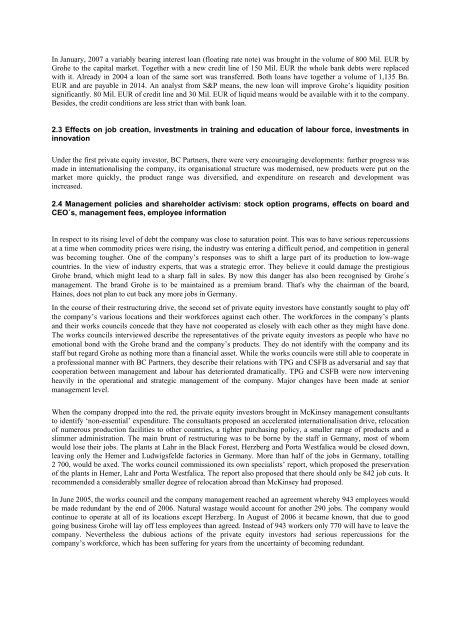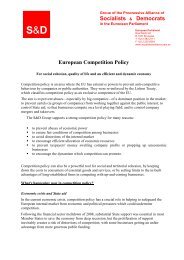Executive summary - Udo Bullmann
Executive summary - Udo Bullmann
Executive summary - Udo Bullmann
- No tags were found...
Create successful ePaper yourself
Turn your PDF publications into a flip-book with our unique Google optimized e-Paper software.
In January, 2007 a variably bearing interest loan (floating rate note) was brought in the volume of 800 Mil. EUR byGrohe to the capital market. Together with a new credit line of 150 Mil. EUR the whole bank debts were replacedwith it. Already in 2004 a loan of the same sort was transferred. Both loans have together a volume of 1,135 Bn.EUR and are payable in 2014. An analyst from S&P means, the new loan will improve Grohe’s liquidity positionsignificantly. 80 Mil. EUR of credit line and 30 Mil. EUR of liquid means would be available with it to the company.Besides, the credit conditions are less strict than with bank loan.2.3 Effects on job creation, investments in training and education of labour force, investments ininnovationUnder the first private equity investor, BC Partners, there were very encouraging developments: further progress wasmade in internationalising the company, its organisational structure was modernised, new products were put on themarket more quickly, the product range was diversified, and expenditure on research and development wasincreased.2.4 Management policies and shareholder activism: stock option programs, effects on board andCEO´s, management fees, employee informationIn respect to its rising level of debt the company was close to saturation point. This was to have serious repercussionsat a time when commodity prices were rising, the industry was entering a difficult period, and competition in generalwas becoming tougher. One of the company’s responses was to shift a large part of its production to low-wagecountries. In the view of industry experts, that was a strategic error. They believe it could damage the prestigiousGrohe brand, which might lead to a sharp fall in sales. By now this danger has also been recognised by Grohe´smanagement. The brand Grohe is to be maintained as a premium brand. That's why the chairman of the board,Haines, does not plan to cut back any more jobs in Germany.In the course of their restructuring drive, the second set of private equity investors have constantly sought to play offthe company’s various locations and their workforces against each other. The workforces in the company’s plantsand their works councils concede that they have not cooperated as closely with each other as they might have done.The works councils interviewed describe the representatives of the private equity investors as people who have noemotional bond with the Grohe brand and the company’s products. They do not identify with the company and itsstaff but regard Grohe as nothing more than a financial asset. While the works councils were still able to cooperate ina professional manner with BC Partners, they describe their relations with TPG and CSFB as adversarial and say thatcooperation between management and labour has deteriorated dramatically. TPG and CSFB were now interveningheavily in the operational and strategic management of the company. Major changes have been made at seniormanagement level.When the company dropped into the red, the private equity investors brought in McKinsey management consultantsto identify ‘non-essential’ expenditure. The consultants proposed an accelerated internationalisation drive, relocationof numerous production facilities to other countries, a tighter purchasing policy, a smaller range of products and aslimmer administration. The main brunt of restructuring was to be borne by the staff in Germany, most of whomwould lose their jobs. The plants at Lahr in the Black Forest, Herzberg and Porta Westfalica would be closed down,leaving only the Hemer and Ludwigsfelde factories in Germany. More than half of the jobs in Germany, totalling2 700, would be axed. The works council commissioned its own specialists’ report, which proposed the preservationof the plants in Hemer, Lahr and Porta Westfalica. The report also proposed that there should only be 842 job cuts. Itrecommended a considerably smaller degree of relocation abroad than McKinsey had proposed.In June 2005, the works council and the company management reached an agreement whereby 943 employees wouldbe made redundant by the end of 2006. Natural wastage would account for another 290 jobs. The company wouldcontinue to operate at all of its locations except Herzberg. In August of 2006 it became known, that due to goodgoing business Grohe will lay off less employees than agreed. Instead of 943 workers only 770 will have to leave thecompany. Nevertheless the dubious actions of the private equity investors had serious repercussions for thecompany’s workforce, which has been suffering for years from the uncertainty of becoming redundant.





